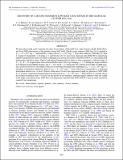| dc.contributor.author | Heinke, C. O. | |
| dc.contributor.author | Altamirano, D. | |
| dc.contributor.author | Cohn, H. N. | |
| dc.contributor.author | Lugger, P. M. | |
| dc.contributor.author | Budac, S. A. | |
| dc.contributor.author | Servillat, M. | |
| dc.contributor.author | Linares, Manuel Alegret | |
| dc.contributor.author | Strohmayer, T. E. | |
| dc.contributor.author | Markwardt, Craig B. | |
| dc.contributor.author | Wijnands, R. | |
| dc.contributor.author | Swank, J. H. | |
| dc.contributor.author | Knigge, C. | |
| dc.contributor.author | Bailyn, Charles D. | |
| dc.contributor.author | Grindlay, Jonathan E. | |
| dc.date.accessioned | 2015-03-12T14:16:50Z | |
| dc.date.available | 2015-03-12T14:16:50Z | |
| dc.date.issued | 2010-05 | |
| dc.date.submitted | 2009-10 | |
| dc.identifier.issn | 0004-637X | |
| dc.identifier.issn | 1538-4357 | |
| dc.identifier.uri | http://hdl.handle.net/1721.1/95972 | |
| dc.description.abstract | We have discovered a new transient low-mass X-ray binary, NGC 6440 X-2, with Chandra/ACIS, RXTE/PCA, and Swift/XRT observations of the globular cluster NGC 6440. The discovery outburst (2009 July 28-31) peaked at LX ~ 1.5 × 10[superscript 36] erg s[superscript –1] and lasted for <4 days above LX = 10[superscript 35] erg s[superscript –1]. Four other outbursts (2009 May 29-June 4, August 29-September 1, October 1-3, and October 28-31) have been observed with RXTE/PCA (identifying millisecond pulsations) and Swift/XRT (confirming a positional association with NGC 6440 X-2), with similar peak luminosities and decay times. Optical and infrared imaging did not detect a clear counterpart, with best limits of V>21, B>22 in quiescence from archival Hubble Space Telescope imaging, g'>22 during the August outburst from Gemini-South GMOS imaging, and J gsim 18.5 and K gsim 17 during the July outburst from CTIO 4 m ISPI imaging. Archival Chandra X-ray images of the core do not detect the quiescent counterpart (LX < (1-2) × 10[superscript 31] erg s[superscript –1]) and place a bolometric luminosity limit of L NS < 6 × 1031 erg s[superscript –1] (one of the lowest measured) for a hydrogen atmosphere neutron star. A short Chandra observation 10 days into quiescence found two photons at NGC 6440 X-2's position, suggesting enhanced quiescent emission at LX ~ 6 × 10[superscript 31] erg s[superscript –1]. NGC 6440 X-2 currently shows the shortest recurrence time (~31 days) of any known X-ray transient, although regular outbursts were not visible in the bulge scans before early 2009. Fast, low-luminosity transients like NGC 6440 X-2 may be easily missed by current X-ray monitoring. | en_US |
| dc.language.iso | en_US | |
| dc.publisher | Institute of Physics/American Astronomical Society | en_US |
| dc.relation.isversionof | http://dx.doi.org/10.1088/0004-637x/714/1/894 | en_US |
| dc.rights | Article is made available in accordance with the publisher's policy and may be subject to US copyright law. Please refer to the publisher's site for terms of use. | en_US |
| dc.source | American Astronomical Society | en_US |
| dc.title | DISCOVERY OF A SECOND TRANSIENT LOW-MASS X-RAY BINARY IN THE GLOBULAR CLUSTER NGC 6440 | en_US |
| dc.type | Article | en_US |
| dc.identifier.citation | Heinke, C. O., D. Altamirano, H. N. Cohn, P. M. Lugger, S. A. Budac, M. Servillat, M. Linares, et al. “DISCOVERY OF A SECOND TRANSIENT LOW-MASS X-RAY BINARY IN THE GLOBULAR CLUSTER NGC 6440.” The Astrophysical Journal 714, no. 1 (April 15, 2010): 894–903. © 2010 American Astronomical Society. | en_US |
| dc.contributor.department | MIT Kavli Institute for Astrophysics and Space Research | en_US |
| dc.contributor.mitauthor | Linares, Manuel Alegret | en_US |
| dc.relation.journal | Astrophysical Journal | en_US |
| dc.eprint.version | Final published version | en_US |
| dc.type.uri | http://purl.org/eprint/type/JournalArticle | en_US |
| eprint.status | http://purl.org/eprint/status/PeerReviewed | en_US |
| dspace.orderedauthors | Heinke, C. O.; Altamirano, D.; Cohn, H. N.; Lugger, P. M.; Budac, S. A.; Servillat, M.; Linares, M.; Strohmayer, T. E.; Markwardt, C. B.; Wijnands, R.; Swank, J. H.; Knigge, C.; Bailyn, C.; Grindlay, J. E. | en_US |
| dspace.mitauthor.error | true | |
| mit.license | PUBLISHER_POLICY | en_US |
| mit.metadata.status | Complete | |
